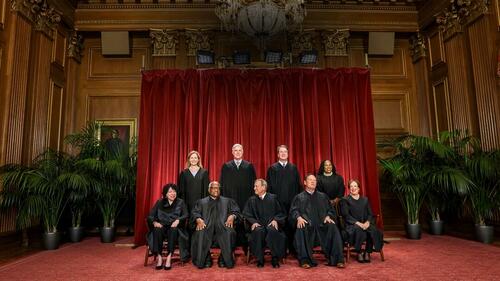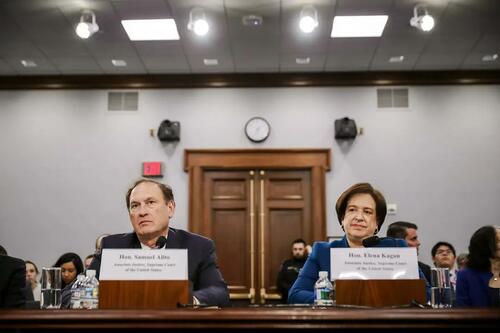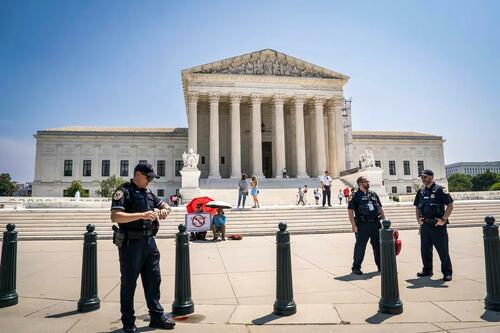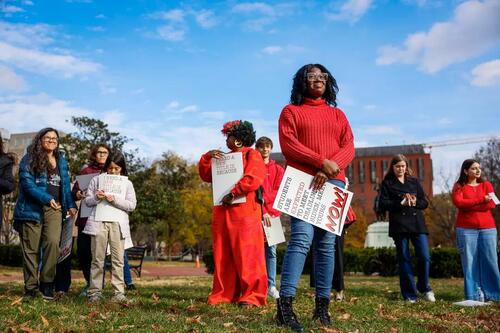Authored by Sam Dorman via The Epoch Times (emphasis ours),
The Supreme Court is expected to start its 2024–2025 term after a blockbuster year of considering contentious cases and challenges to longstanding precedent.
Already, the court has accepted petitions related to hot-button topics including gender, ghost guns, immigration, pornography, and e-cigarettes. The term starts on Oct. 7.
 (L–R) U.S. Supreme Court Associate Justices Sonia Sotomayor, Amy Coney Barrett, Clarence Thomas, Neil Gorsuch, Chief Justice John Roberts, Associate Justices Brett Kavanaugh, Samuel Alito, Ketanji Brown Jackson, and Elena Kagan pose for their official portrait at the East Conference Room of the Supreme Court in Washington on Oct. 7, 2022. Alex Wong/Getty Images
(L–R) U.S. Supreme Court Associate Justices Sonia Sotomayor, Amy Coney Barrett, Clarence Thomas, Neil Gorsuch, Chief Justice John Roberts, Associate Justices Brett Kavanaugh, Samuel Alito, Ketanji Brown Jackson, and Elena Kagan pose for their official portrait at the East Conference Room of the Supreme Court in Washington on Oct. 7, 2022. Alex Wong/Getty ImagesAs the session begins, here are some potential developments to look out for. Besides new legal questions, legal issues from the prior term could resurface and help shape decisions on new cases in the 2024–2025 term.
Trump Back at Supreme Court?
Last term, the Supreme Court heard several cases related to former President Donald Trump, resulting in landmark rulings on immunity and the disqualification clause under the 14th Amendment.
The immunity ruling in Trump v. United States held that presidents enjoy different levels of immunity from criminal prosecution. That ruling stemmed from an appeal Trump filed in his election interference case brought by special counsel Jack Smith in the D.C. Circuit.
Both the immunity decision and another related to Jan. 6 defendants could return to the Supreme Court as Trump’s legal team raises their arguments in Washington.
In Fischer v. United States, the Supreme Court restricted the use of an Enron-era obstruction charge in Jan. 6 cases. This obstruction charge was leveled against Trump in the federal election case. On Oct. 3, Trump submitted a brief asking District Judge Tanya Chutkan to remove that portion of the indictment based on Fischer.
So far, Chutkan has set a timeline through the beginning of November with opportunities for Trump’s legal team to make arguments on immunity and the special counsel.
A status conference on Sept. 5 indicated that Trump and Chutkan would disagree about how she should apply the Supreme Court’s decision to Smith’s superseding indictment—making an appeal likely. If the U.S. Court of Appeals for the D.C. Circuit agrees with Chutkan’s eventual decision, Trump will likely appeal the decision to the Supreme Court.
Trump is also expected to file a motion in D.C. court arguing that Special Counsel Jack Smith’s appointment was illegal. District Judge Aileen Cannon found Smith’s appointment was unauthorized and dismissed the classified documents case in Florida, but her ruling is not binding in the D.C. Circuit, where there is a previous ruling to the contrary.
 Republican presidential candidate and former President Donald Trump speaks in the library at Mar-a-Lago in Palm Beach, Fla., on March 4, 2024. Alon Skuy/Getty Images
Republican presidential candidate and former President Donald Trump speaks in the library at Mar-a-Lago in Palm Beach, Fla., on March 4, 2024. Alon Skuy/Getty ImagesSmith has also filed a large immunity brief, indicating the appeals on that issue could be complex. Trump’s team is set to reply with a very large brief of their own.
Smith has appealed Cannon’s decision. With the appointment question being challenged in two circuits, this could create a circuit split, or differing legal rulings on the same issue in different circuits, which often prompts the Supreme Court to take up the matter to resolve the conflict.
If Trump wins reelection, each of the federal criminal cases will likely be withdrawn.
It’s unclear how the New York case, which involves state charges, will conclude, but Trump has already vowed to appeal. The state-level prosecution in Georgia could also reach the Supreme Court as it’s expected to face immunity-related objections from Trump.
Calls for Reform
Regardless of who wins the presidency, Democrats will likely continue pressing for reform to the nation’s highest court—attracting further scrutiny to the justices and amplifying the tension surrounding hot-button issues like gender.
Recent polling from the University of Pennsylvania indicated that Democrats may be able to gain traction with proposals for term limits and ethics reform. Court-packing, or adding more justices to the court, polled relatively low with just 3 in 10 Americans supporting such a proposal.
Democrats didn’t make much headway on their proposals in recent terms, but that could change depending on who wins Congress and the presidency in the 2024 elections.
Besides court-packing and term limits, a binding ethics code has been floated by Democrats. Whatever passes could come before the Supreme Court itself. The court already implemented its own code of ethics in 2023 but faced criticism for not including an effective enforcement mechanism.
Since then, justices Ketanji Brown Jackson and Elena Kagan have backed some kind of ethics enforcement. It’s unclear, however, how court as a whole might rule on something like this. Justice Samuel Alito, who has been a target of Democrats’ ethical concerns, previously told The Wall Street Journal: “No provision in the Constitution gives [Congress] the authority to regulate the Supreme Court—period.”
 U.S. Supreme Court associate justices Samuel Alito (L) and Elana Kagan testify about the court's budget during a hearing of the House Appropriations Committee's Financial Services and General Government Subcommittee in Washington on March 7, 2019. Chip Somodevilla/Getty Images
U.S. Supreme Court associate justices Samuel Alito (L) and Elana Kagan testify about the court's budget during a hearing of the House Appropriations Committee's Financial Services and General Government Subcommittee in Washington on March 7, 2019. Chip Somodevilla/Getty ImagesReforming the Supreme Court could prove more difficult than other reforms advanced by Congress. Article III of the Constitution, which allows judges to hold office “during good Behaviour,” has long been interpreted to offer life tenure.
Imposing term limits would likely require an amendment to the Constitution. Besides proposing term limits, both President Joe Biden and Vice President Kamala Harris have advanced the idea of a constitutional amendment that bars presidents from enjoying immunity from criminal prosecution.
Guns
So far, the court has said it will take at least one major firearm-related case called Garland v. VanDerStok, which surrounds the government’s attempt to regulate so-called “ghost guns.” The term refers to firearms that are untraceable, because they lack serial numbers and are made outside of the normal process involving a licensed manufacturer.
Oral argument for that case is set for Oct. 8, months after the Supreme Court issued its decision on bump stocks, which are accessories added to guns to increase the rate of fire.
Both that case (Garland v. Cargill) and the VanDerStok case involve the DOJ, through the Bureau of Alcohol, Tobacco, Firearms, and Explosives (ATF) attempting to interpret decades-old laws to prohibit certain products.
In the bump stocks case, a 6–3 majority held that ATF exceeded its authority in outlawing bump stocks based on statutory phrasing in federal law.
The VanDerStok case focuses on the Gun Control Act of 1968, which contains language about firearms, frames, and receivers that ATF interpreted to cover weapons kits and incomplete frames and receivers. Unlike the court’s decision in prior gun cases, such as a case last term surrounding gun rights for domestic abusers, this case focuses on statutory interpretation rather than judging how a government’s action aligns with the Second Amendment.
The solicitor general’s brief expressed particular concern about how guns constructed from these parts were able to evade law enforcement protection because they didn’t follow the Act’s requirements, including providing serial numbers.
It also expressed concerns over the impact on minors. “Minors in particular ‘have discovered the ease with which they can acquire the parts for a ghost gun’ and ‘have been buying, building[,] and shooting the homemade guns with alarming frequency,’” the brief read, quoting a Washington Post article on the subject.
Two Texas residents—Jennifer VanDerStok and Michael Andren—along with Tactical Machining, a producer and retailer, and the advocacy group Firearms Policy Coalition, sued ATF.
 A person holds a 3D-printed ghost gun during a statewide gun buyback event held by the office of the New York State Attorney General in the Brooklyn borough of New York on April 29, 2023. Yuki Iwamura/AFP via Getty Images
A person holds a 3D-printed ghost gun during a statewide gun buyback event held by the office of the New York State Attorney General in the Brooklyn borough of New York on April 29, 2023. Yuki Iwamura/AFP via Getty ImagesVanDerStok and her co-respondents told the Supreme Court that ATF’s definition isn’t logical and that the agency is attempting to regulate items that aren’t frames or receivers.
The court has just started to announce the cases it’s taking, meaning that there are plenty more—including gun cases—it could decide to hear. It could also take up a challenge to Maryland’s “assault weapons ban,” which the U.S. Court of Appeals for the Fourth Circuit upheld as not violating the Second Amendment.
On Oct. 4, the Supreme Court also agreed to take up the Mexican government’s claims that U.S. gun companies have engaged in business practices, such as failing to impose sales restrictions, that benefitted cartels in Mexico. A district court ruled against Mexico but that decision was later reversed in the First Circuit, prompting the gun companies to appeal to the Supreme Court.
Pornography and E-Cigarettes
Youth public health is coming up in two other major cases—one involving the Food and Drug Administration’s (FDA) refusal to approve flavored e-cigarette products and another challenging Texas’ law requiring age verification on pornographic sites.
Industry groups have brought legal challenges to those decisions with both of their cases reaching the U.S. Court of Appeals for the Fifth Circuit. The Supreme Court said it would take up both cases, although the dates for oral arguments haven’t been announced.
The pornography case is Free Speech Coalition v. Paxton, as in Texas Attorney General Ken Paxton, who has accused the industry of trying “to keep minors in their audience.” The Free Speech Coalition, a trade association for adult entertainment companies, described Texas’ law as “ invasive and burdensome, with significant privacy risks for adult consumers.”
It’s unclear how the two cases will be resolved. Nearly 20 states have passed laws requiring age verification for pornographic platforms. The Supreme Court’s decision could change how lower courts evaluate First Amendment challenges to porn restrictions.
The Coalition is arguing that the Fifth Circuit erred in applying a lower standard of review, or requiring less from the government in showing its restriction on speech was justified.
Erin Hawley, who serves as senior counsel at Alliance Defending Freedom, said the Supreme Court will likely focus on that question.
 A worker organizes boxes of e-cigarettes and vape devices in a local store in Jersey City, N.J., on Jan. 2, 2020. Eduardo Munoz Alvarez/Getty Images
A worker organizes boxes of e-cigarettes and vape devices in a local store in Jersey City, N.J., on Jan. 2, 2020. Eduardo Munoz Alvarez/Getty Images“Oral argument in this case will be very interesting,” she said during an event at the Heritage Foundation on Oct. 2. “I think it’s really just the tip of the iceberg as well. As we know from the Supreme Court’s decisions in Netchoice and the other cases—how states grapple with social media companies while also protecting First Amendment freedoms is something that ... will be on the Supreme Court’s plate in the next few years.”
In the e-cigarette case (FDA v. Wages and White Lion), the Fifth Circuit ruled in favor of the industry. The appeals court reasoned that the Food and Drug Administration’s rule violated the Administrative Procedure Act (APA) by, among other things, not considering the manufacturers’ marketing plans or giving them fair notice before allegedly changing its approach to approval.
On Oct. 4, the court said it would take another e-cigarette case from the Fifth Circuit—this time questioning whether a manufacturer erred in how it filed its lawsuit against the FDA.
Administrative Law
The APA, passed in 1946 after the New Deal era, was critical to one of the court’s most controversial decisions in its prior term that overturned the decades-old Chevron precedent.
Writing for the majority, Chief Justice John Roberts said in Loper Bright Enterprises v. Raimondo that courts had been judging agency decisions based on a misinterpretation of the APA. The Chevron doctrine required courts to defer to agencies’ reasonable interpretations of law when there were ambiguities.
Kagan’s dissent said the majority “disdains restraint, and grasps for power” by overturning the decades-old Chevron precedent.
Dan Greenberg, general counsel at Competitive Enterprise Institute, a libertarian think tank, disagreed.
“Loper Bright really indicates a stronger and stronger desire by the Supreme Court to instruct every other part of government to stay in its lane,” Greenberg told The Epoch Times.
Greenberg said he thought it was “highly likely” the court would grant certiorari, or agree to take on, Consumers’ Research v. Federal Communications Commission (FCC). That case questions whether Congress unconstitutionally delegated its power to raise revenue to the FCC.
Hawley suggested that Loper Bright could also impact a case being heard in October involving the U.S. Environmental Protection Agency’s (EPA) Clean Water Act.
In City and County of San Francisco v. EPA, city officials said the federal agency’s regulations for wastewater discharge permit holders are too vague to follow.
“I would imagine that post-Loper Bright that San Francisco will win this one,” Hawley said.
 The U.S. Supreme Court in Washington on July 29, 2024. Madalina Vasiliu/The Epoch Times
The U.S. Supreme Court in Washington on July 29, 2024. Madalina Vasiliu/The Epoch TimesGender
In the 2023–2024 term, the court took on many hot-button issues but seemed intent on leaving one, in particular, gender, for another term. This summer, the justices took the long-awaited step of taking up a case on gender, which touches on various aspects of federal law.
In that case, U.S. v. Skrmetti, the Biden administration is challenging Tennessee’s ban on gender transition procedures for minors. The administration contends that Tennessee’s ban is a form of discrimination that violates the equal protection clause.
The case is likely to set a major constitutional precedent and be one of the most watched for in the upcoming term.
It will also present an opportunity for the court and its various justices to clarify the stances they took in a similar case, Bostock v. Clayton County, from 2020. In that case, Justice Neil Gorsuch joined a majority of the court in holding that employment discrimination on the basis of sexual orientation and gender identity violated Title VII’s prohibition on sex-based discrimination.
Its decision was rooted in the idea that discrimination based on sexual orientation or gender identity was ultimately based on sex.
That decision has played a role in lower court decisions on gender-related medical procedures, as well as litigation over Title IX, or the civil rights statute prohibiting sex-based discrimination in education.
 Activists rally to call on President Joe Biden to finalize a new Title IX rule to help protect victims of sexual assault and LGBTQ students on college campuses, in Lafayette Park near the White House on Dec. 5, 2023. Anna Moneymaker/Getty Images
Activists rally to call on President Joe Biden to finalize a new Title IX rule to help protect victims of sexual assault and LGBTQ students on college campuses, in Lafayette Park near the White House on Dec. 5, 2023. Anna Moneymaker/Getty ImagesEarlier this year, the Biden administration prompted a flood of lawsuits when it passed an Education Department rule interpreting Title IX to apply to sexual orientation and preferred gender identity. Conservatives have argued that doing so wrongly forces women to compete with men in athletics and share spaces like locker rooms with them.
The court ultimately declined to take up the issue in August when the justices refused to grant the Biden administration emergency relief from blocks that the Fifth and Sixth circuits placed on the rule. Conservatives have also asked for the court to take up two other Title IX cases originating in Idaho and West Virginia.
Whatever the court decides, it could impact how the American legal system views gender and its implications in a wide range of contexts.
Source link

